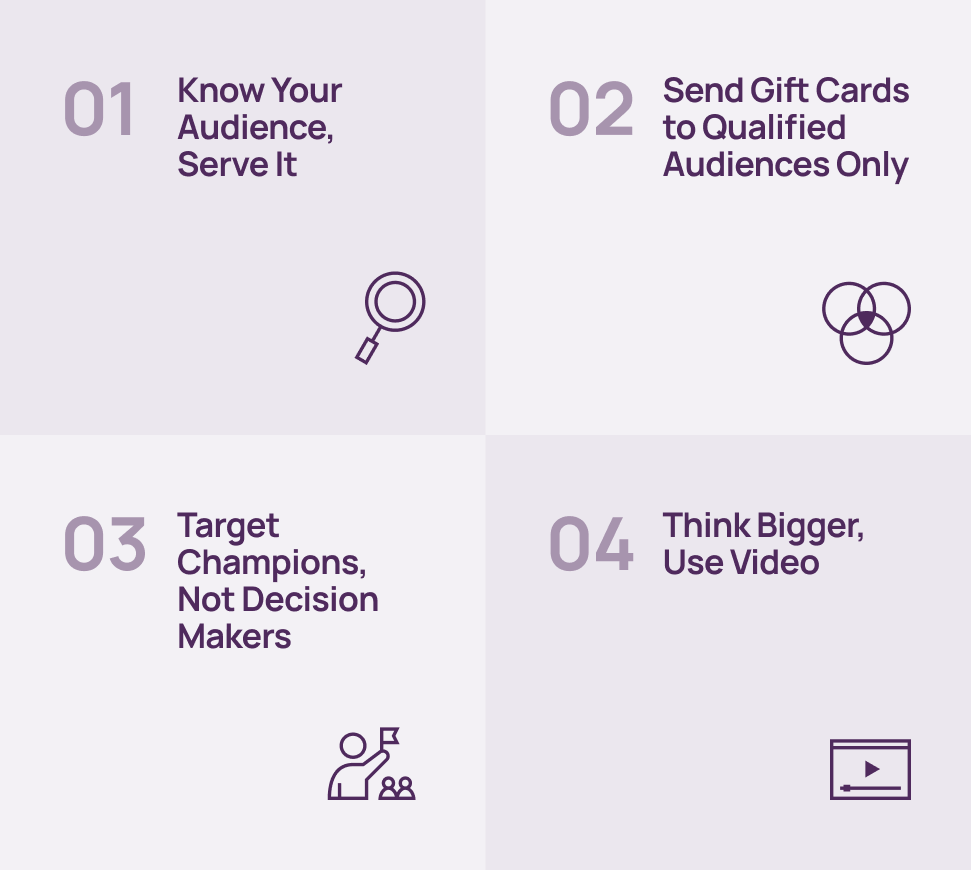“I won’t glance twice at a LinkedIn message if there’s no incentive attached to it. Sorry, not sorry, but I don’t have time for a pitch if I can’t also use the time to order new golf balls on Amazon with the gift card I got from that intro call,” Anonymous (from an internal poll).
This response isn’t isolated. Your pitch, your hilarious email, your clever turns-of-phrases aren’t worth the digital ink they’re written with if you don’t offer more. Potential customers are busy. And in this “dynamic world of B2B SaaS marketing, where strategies and tactics evolve faster than we can keep track of,” people will still argue that gift cards simply don’t work. (Editor’s note: I tried to use as much jargon as possible in this sentence for effect. FOR EFFECT!)
- “Gift cards are cheap meetings!”
- “They’re not real marketing!”
- “Worst hack ever!”
Yes, the reputation of a gift card has become one that marketers love to hate. But why?
“I genuinely hate gift cards too, they can feel icky. But the biggest ick of all is losing a deal I could have won,” Directive’s CEO, Garrett Mehrguth chimes in. “Marketers love to hate on gift cards. But in the last 36 months, I drove $15M+ in revenue for Directive giving away Amazon gift cards.”
Gift cards may not be the preferred go-to, but honestly, they work. And without them, B2B may not be what it is.
Let’s explore this a bit more.
What are the Real Objections to Gift Cards?
If you have to pay someone to listen to you, does that make what you’re saying less valuable? Or does it perhaps show your listener you value their time?
Some marketers say that gift cards devalue a meeting, and actually lead to lower conversion rates. Maybe, though, this argument instead hides a deeper sentiment. Maybe marketers think they’re too good for this.
Looking closer, though, gift cards are not about lowering the value of a meeting or compromising quality—they are a strategic incentive to drive action. They serve as a catalyst to move prospects from apathy to engagement.
The Getting-Going-With-Gift-Cards Plan of Action
ACTION 1
Know Your Audience, Serve It
If you want your gift cards to actually work, you need to be specific with your messaging. This means you must target one audience with a focused value proposition, and consider your product’s unique selling points to that audience. Now, hone in on a singular title in a specific vertical like a Director of Demand Generation at SaaS companies with over 200 employees.
Boom.
A simple yet focused approach.
Why does this work? With a narrow focus, you increase the relevance of your message, shortening the time to value for your prospects. You are not attempting to be Salesforce overnight; instead, emulate the success of more niche-focused companies like Gong by offering precise solutions to a well-defined audience.
Directive’s VP of Strategic Engagements, Drew Choco, knows this. He says, “Marketers should use [gift cards] because it allows you to generate sales meetings from a platform like LinkedIn, where there is no search intent.” Drew elaborates, “If you have a specific niche that you are going after, the best way to get in front of them is on a channel where you can actually control firmographics, technographics, etc. This is also a great way to control ACV, because again, you have control over the types of accounts you’re reaching out to.”
Further, Drew explains, “A lot of people who take the call are actively looking for our services. I hear a lot of, ‘What intent data are you using to target me?’ The reality is, they likely saw our ad a number of times, but chose to respond because they were actively looking for what we do, and get gift card out of it.”
ACTION 2
Send Gift Cards to Qualified Audiences Only
Not all potential customers are created equal.
Your gift card strategy should reflect this. The key to success is manual verification of your Total Addressable Market (TAM). Map out and verify every account you plan to target, ensuring they align with your ideal customer profile.
When you’re only advertising to your manually-verified audiences, you can rest assured your budget won’t go to waste. The goal of all of this direct response advertising is to get the right person from the right account into a sales moment. You know what doesn’t get people to a sales moment? Whitepapers.
Who’s your audience? We can help!
Check out this Customer Segmentation & Personas Worksheet to get you headed in the right direction!

ACTION 3
Target Champions, Not Decision Makers
What’s that saying? My enemy’s enemy is my friend? This is sorta like that. Sorta.
It doesn’t seem intuitive, but targeting C-level executives directly isn’t going to do what you think it’s going to do. Why? C-level execs empower their direct reports and trust them to make the right choices. This means, you should be talking to the teams of the C-Levels, or, as we call them, the champions.
Champions could be more receptive to incentives like gift cards. All you have to do is gain their trust. This bottom-up approach can lead to higher conversion rates and stronger relationships with key stakeholders.
“I’ve been approached a million times by my CEO saying, ‘What do you think about this tool, Will?’” Directive’s Director of Content Marketing, Will Price details. “I’ll come to him with a business case for a tool or solution, but rarely does he champion something. I just need his signature on the contract. Trust is a crucial thing.”
ACTION 4
Think Bigger, Use Video
Think for a second: Have you ever seen an insurance company advertise an eBook? Or a car company promote a data sheet? That information is readily available. Yet they don’t leverage these assets to bring people to a sales moment (CALLBACK!). No, instead, they use creative, compelling commercials to capture attention.
One time, a salesperson sent us a video of himself playing with his puppy. There was a gift card attached, too, but honestly, the puppy sold it, and we hopped on that call.
Film a 30-second live-action commercial that highlights your product’s value and promote it alongside your gift card.
PRO TIP: Make sure your budget is small enough that you don’t need to prove ROI directly to the CFO immediately. This allows for sustained engagement without constant scrutiny.
Additionally, set up retargeting audiences for those who engage with your video ads. These audiences often become your top-performing segments, amplifying the impact of your gift card campaigns.
How do you get started with video?
“Worry way more about what to say and way less on the production value of it,” Directive, Director of Video, Mike Farnham says. “Sharpen that axe most of the day, then chop the cherry tree.”

CLOSING THOUGHTS
Gift cards work.
“Gift cards may not be the magic carrot,” explains Mia White, Directive’s Director of Strategic Engagements. “But whatever aligns with the ideal customer to move them from apathy to action.”
Gift cards have outperformed other approaches we’ve tested, including Allbirds, Yeti Coolers, donation matching, discounts, and credits. And they’re easier to send.
If you’re in a moral quandary about using them, just remember, there’s no prize for being “anti-something.”
The gift card is not the value proposition itself; it’s an incentive to drive action. When executed thoughtfully, it can be a powerful tool to create meaningful interactions and conversions.
Do what works for your organization.
-
 Will Price
Will Price
Did you enjoy this article?
Share it with someone!
